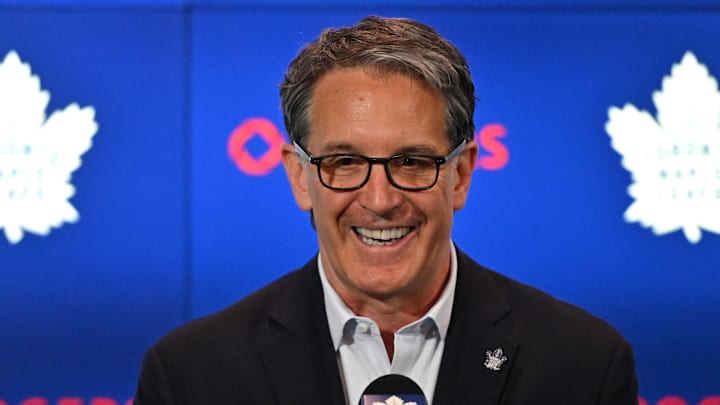The Toronto Maple Leafs GM Wars are getting really old and boring.
The Toronto Maple Leafs old GM was a polarizing figure because he (ever so slightly, it must be noted) tried to innovate in a league that is extremely hostile to innovation. While most people have moved on, those who hate him cannot stop brining him up in conversation, which is to be fair, an extremely small portion of people, but, like everything else in the world today, the smallest and most ridiculous faction will steer the conversation if it is the loudest.
I bring this up not to rehash talk about the guy who used to run the Leafs, but to talk about the new GM, Brad Treliving.
The fact that Treliving signed Nylander instead of option out of the CORE FOUR strategy pretty much confirms what we already know: Brendan Shanahan is the man in charge of the Toronto Maple Leafs and he wants to at least give himself until the end of the Tavares' contract to prove that he was right.
The Leafs under Dubas were most known for is the Studs and Duds approach to roster building. This means they took most of their cap space and allotted it to a small group of superstars while looking to fill out the roster on the cheap.
But then when they re-signed Nylander they basically doubled down on this strategy and that is fine. To be honest, I think it's the correct strategy for how to build a roster in a salary cap league. However, doubling down on that strategy made no sense with what Brad Treliving did before the season started.
Since they are clearly not idiots, it makes you think that maybe they wanted to trade Nylander but didn't like what was out there for trades. The only problem is this mid-season switcharoo really threw a wrench into what they could do with their current roster. (See how they did basically nothing at the trade deadline, despite Auston Matthews and Mitch Marner being at what are most likely the peaks of their careers).
The Toronto Maple Leafs Doomed By Incompatible Strategies
Dubas, the pioneer of this concept, realized that there is a huge gap between what name-brand but non-star players get paid and what they give to the team. For example, Max Domi is not a star, merely very good. But the difference between a league minimum player and a "very good but not a star" player is less than the difference in their salaries, making the Domi's of the world a very bad investment.
Essentially, all "star players" are worth at least one win and as much as seven or eight for the MVP. But that only encompasses 10% of the league. The other 90% of players are worth between zero and .99 wins.
Therefore, assuming this is true, you can dump all your money into star players by using the savings spent on non-stars. Under this rule, you search for Michael Bunting's and David Kampfs and pay them the league minimum. When you want to break your own rule, like Dubas did with Jarnkrok, you add extra years no one else would consider to make the cap-hit as low as possible.
You're giving up on the marginal gains you get from paying Domi instead of using Alex Steeves, but the $2 million dollars you save can then be put towards a player who "moves the needle." A good way to think of is like this: you can pick between having 2 x Justin Holl's who make the salary the Red Wings are paying him, or you can have a rookie Justin Holl and a Jake Muzzin. You'd take the later every time, and Shanahan/Dubas built the Leafs around this concept.
When this works, you can have room to add, as we saw last year when the Leafs added Ryan O'Reilly, Jake McCabe, Luke Schenn, Noel Acciari, Sam Lafferty and Erik Gustuffson last year at the deadline. That is an incredible haul for any team, let alone one supposedly weakened by paying the Core Four so much money.
But it doesn't work when you star paying non-star players big money. You can't do this strategy and make David Kampf the highest paid fourth liner in the NHL. The reason I think the Leafs planned to move Nylander all along was because otherwise their summertime moves didn't make any sense.
Shanahan and Treliving brought in Tyler Bertuzzi who is nice, but he's not a star. $5 million. Domi is not even close to a star, he got $3 million. Then there was Samsonov at $3 million and Kampf at $2.4 million, Reaves at $1 and finally John Klingberg at $4 million.
The Studs and Duds strategy that Dubas and Shanahan pioneered cannot work with this kind of spending. It leaves the bottom of the roster too exposed and cost the team the ability to have one, maybe two more stars.
The Leafs have almost $24 million going to seven non-star players. The math that Kyle Dubas used to justify the Studs or Duds approach says you should insert four or five league minimum players in their place and then split the other $18 million between two or three more stars.
The Leafs should have stuck with what they were doing, or abandoned it completely. Unfortunately, when they signed Nylander, they were already half way down the road to abandoning this strategy and siging Nylander recommitted them to it. Now they're still doing the studs and duds thing, but they are doing it in a way that can't really work.
The Toronto Maple Leafs, like his biggest haters, need to move on from Kyle Dubas. He is gone, and they need to either fully commit to the strategy he pioneered or move on. This year has shown that you can't really split the difference.
